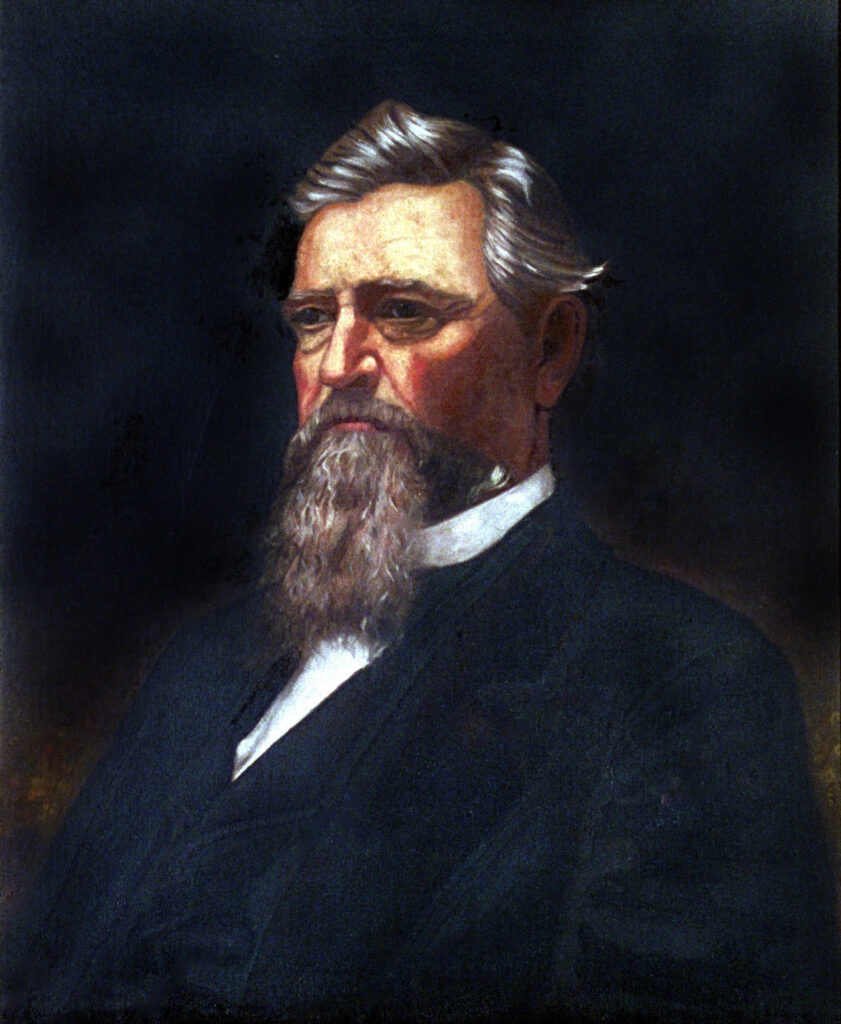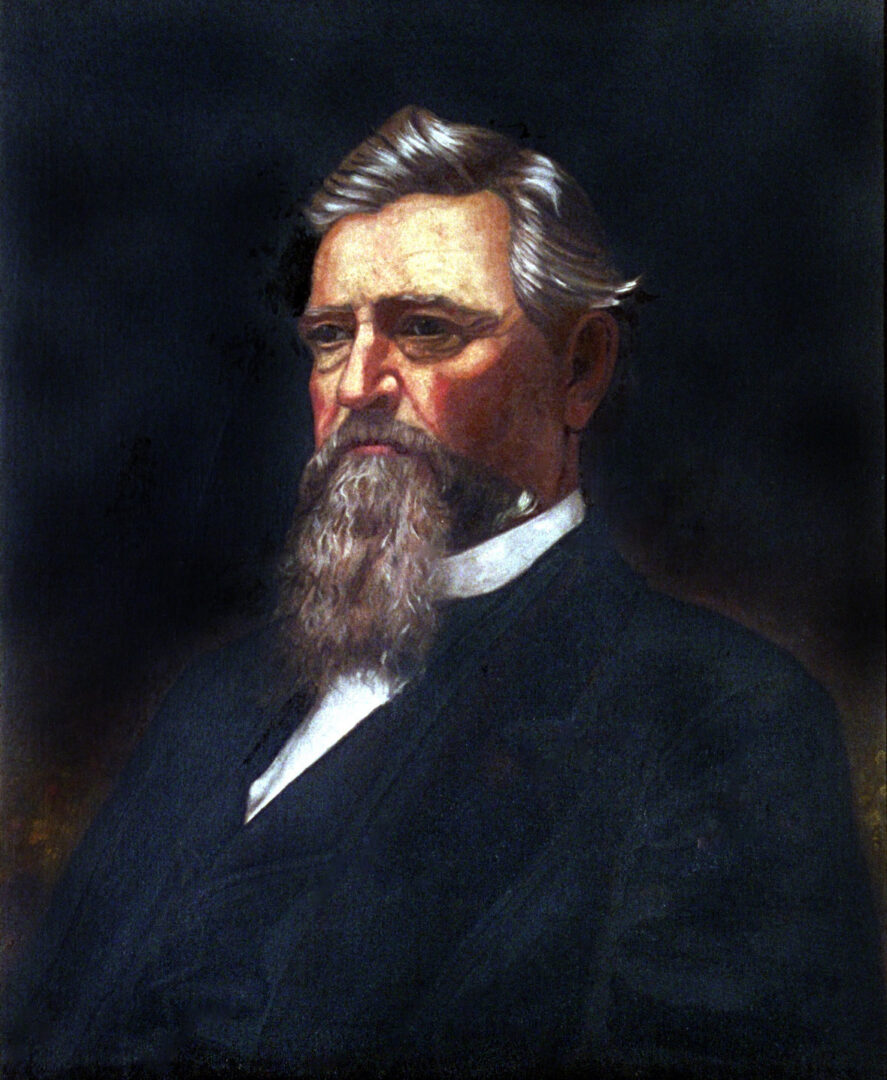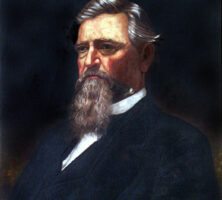James M. Smith, a lawyer, Confederate colonel, and Confederate congressman, served as Georgia’s governor from 1872 to 1877. Smith rose to the chief executive office on the tide of reaction against Radical Republicanism that toppled Governor Rufus Bullock in 1871. Smith’s election marked the end of Reconstruction in Georgia and the beginning of more than a century of Democratic Party rule.
Early Life and Career
James Milton Smith Jr. was born to Martha and James Smith on October 24, 1823, in Twiggs County. He was educated in Culloden in Monroe County, where his father farmed and preached. Smith worked as a blacksmith, studied law, and by the 1850s established himself as an attorney in Thomaston, in Upson County. In 1855 he campaigned unsuccessfully as a Democrat for the Third Congressional District seat. In January 1861, three weeks before Georgia seceded from the Union, he won the Flint Circuit Superior Court judicial election but opted for Confederate military service with the Upson Volunteers.

Courtesy of Georgia Capitol Museum, University of Georgia Libraries
Smith was wounded at Gaines’ Mill, Virginia, in 1862 but returned to duty and fought in the battles of Chancellorsville, Fredericksburg, Gettysburg, and Sharpsburg. Eventually promoted to colonel and regimental commander of the Thirteenth Regiment Georgia Volunteer Infantry, he left the service in 1863 and returned to Georgia, where he was elected Seventh District representative to the Second Confederate Congress.
After the war, Smith moved his law practice to Columbus. There, in 1868, he joined a defense team led by Alexander Stephens in a much publicized—and ultimately unresolved—Reconstruction murder case in which several Muscogee County men were accused of the alleged Ku Klux Klan murder of George W. Ashburn, a Republican organizer. Two years later Smith won a Muscogee County state representative seat in the conservative landslide that restored the Georgia General Assembly to Democratic control.
“Redeemer” and Governor
When the “Redeemer” legislature was seated in November 1871 in the wake of Governor Bullock’s resignation, Smith was elected house speaker. Later that same month the assembly called an immediate special election for governor (over the veto of interim Republican governor Benjamin Conley). On December 6 a party caucus chose Smith to be the Democratic candidate. Republicans called a boycott of the election, and in what was virtually ano-contest election on December 19, Smith was elected governor with a mere 39,000 votes out of the state’s more than 200,000 eligible voters.
In the regular quadrennial general election of 1872, Smith overwhelmed Republican Dawson Walker with a landslide victory of more than 60,000 votes. The campaign was characterized less by issues than by political maneuvering, and the election was conveniently rescheduled to avoid the complicating presence of federal marshals. All of this took place amid numerous reports of Democratic electoral manipulation, vote fraud, intimidation, and Ku Klux Klan violence.
Smith inherited a poor state that was saddled with debts. Investigations of the prior government’s expenditures and of railroad deals produced evidence of widespread corruption and mismanagement. The legislature reacted by repudiating millions of dollars in bonded debt, and Smith proposed ways for the state to improve economic productivity and increase revenue while reducing expenses. He urged the creation of a state department of agriculture, and he created a state geological office to produce a survey of Georgia’s mineral resources. His promotion of a canal to join the Coosa and Tennessee rivers failed to generate interest, however, and his decision to allocate the state’s entire Morrill Act receipts for a state agricultural school at Athens was criticized as contrary to the act’s intent, which was to establish “agricultural and mechanical” schools in areas previously unsupported by higher education.
Among the most controversial of Smith’s acts was his institutionalization of the convict lease system. The policy of “leasing” convicted felons out as laborers to railroad builders had been in place for several years, and it represented a way to continue supporting Georgia’s extensive railroad investment at the same time that the legislature was repudiating railroad bonds and that Smith was calling for legislation barring such forms of subsidy. Publicly he defended selling convict labor to contractors through twenty-year leases worth $500,000 to the state as a practical necessity. Otherwise, the state would simply have to pay for a costly state penitentiary to house Georgia’s rapidly growing convict population. During Smith’s administration the number of state convicts grew from 385 to 926, 90 percent of them Black, an increase that Smith assured Georgians was due not to an increase in crime but to “a more rigid enforcement of the laws.”
Historians generally identify Smith’s administration as furthering the agenda of Georgia’s Bourbon Democrats, or “New Departure” Democrats, who aimed Georgia toward a New South economy adapted to the ex–slave society’s priorities of white supremacy and rigid control of labor. As Smith told a state agricultural convention at Athens in August 1873, “We may hold inviolate every law of the United States and still so legislate upon our labor system as to retain our old plantation system, or, in lieu of that, establish a baronial one.”
Later Career
After leaving the governorship, Smith made an unsuccessful attempt for a U.S. Senate seat in 1877 and then returned to the practice of law in Columbus. In 1879 Governor Alfred H. Colquitt appointed him to a six-year term on the newly organized state railroad commission, for which Smith served as chairman. Governor Henry McDaniel did not reappoint Smith to the commission in 1885, and Smith returned to his law practice until May 1887, when Governor John B. Gordon appointed him to fill a judicial vacancy on the Chattahoochee Circuit Superior Court. He was reelected by the legislature to a four-year term in November 1888.
Smith suffered a stroke and died after a long period of illness on November 25, 1890. Married twice, to Hester Ann Brown (who died in 1880) and Florida Abercrombie Wellborn, Smith had no children. He was buried in Gainesville’s Alta Vista Cemetery beside his first wife.






